Anoplolepis (Zelalleyella) custodiens (F. Smith)
  Type locality South
Africa (Formica custodiens, F. Smith, 1858b: 33, worker;
Mayr, 1895: 148, male) moved to Anoploplepis by Emery (1925b:
17) Port Natal. Type locality South
Africa (Formica custodiens, F. Smith, 1858b: 33, worker;
Mayr, 1895: 148, male) moved to Anoploplepis by Emery (1925b:
17) Port Natal.
Junior synonyms
hendecarthrus (Camponotus
hendecarthrus nov. sp., Roger, 1863a: 132, worker & queen) from
South Africa, Cape of Good Hope (Paris Museum) - no
images on Antweb (June 2014).
berthoudi (Formica berthoudi, Forel, 1876:
33,
worker) from Lesotho - no images on Antweb (June 2014).
subspecies
detrita (Plagiolepis
custodiens F Smith var. detrtita
n. var., Emery 1892a: 118, workers) from Somalia - see http://www.antweb.org/specimenImages.do?code=casent0905134
hirsuta (Plagiolepis
custodiens F Smith var. hirsuta
n. var., Emery 1892a: 118, workers) from Somalia - see http://www.antweb.org/specimenImages.do?code=casent0905135
pilipes (Plagiolepis
custodiens F Smith var. pilipes
n. var., Emery 1892a: 118, workers) from Somalia - see http://www.antweb.org/specimenImages.do?code=casent0905133
all forms
described; in subgenus Zealleyella (see Bolton, 1995).  . .
|
Smith's (1858b) cursory description is at  . Roger's (1863a) description of Camponotus
hendrecarthus is at . Roger's (1863a) description of Camponotus
hendrecarthus is at  . Emery's (1892a)
descriptions of detrita, hirsuta and pilipes
are at . Emery's (1892a)
descriptions of detrita, hirsuta and pilipes
are at  . Forel's (1895) description of the male is
at . Forel's (1895) description of the male is
at  . Arnold (1922) gave a full description;
the worker is at . Arnold (1922) gave a full description;
the worker is at  and sexuals at and sexuals at  . .
|
 Forel
(1876) described berthoudi from Lesotho as follows (comparison
with others of the genus Formica, my translation) (drawing
below right from Arnold, 1922: 582) - Forel
(1876) described berthoudi from Lesotho as follows (comparison
with others of the genus Formica, my translation) (drawing
below right from Arnold, 1922: 582) -
WORKER - TL 9.0-9.5 mm; head large, and wide (HW 2.2 mm), rounded and
impressed posteriorly; genae much bigger. Mandibles long (1.5 mm),
crossing, more slender and of agressive form ("proportion gardeé"),
apical border longer; internal border short, indistinctly separable
from the apical border by an obtuse angle; apical border with 7-8
strong black teeth, smooth and irregular between 6 and 7 posteriorly,
about twice as long as those in F. rufa. Clypeus ("chaperon")
without distinct carinae; anterior border extended forward medianly and
feebly on each side. Frontal carinae long, slightly divergent, near
straight (sometimes a little convex laterally). Three very small
rudimentary ocelli. Eyes and ocelli situated more posteriorly than F.
rufa, eyes a little smaller. Maxillary palps with six segments very
short, especially the last two segments. Labial palps with four
segments, apical two together as long as the first. Antenna more
slender, longer, specially the scape, 11-segmented; segments 2-10
diminish evenly in length from 2 to 10. The thorax is similar in size
and almost the same shape as F. rufa (large workers); the head
relatively is smaller and narrower in F. rufa ( HW rufa
2 mm, berthoudi 2.2 mm); thorax width is 1.4 mm in both
species. Only the propodeum (metanotum) is a little different, with the
dorsum and the declivity distinctly separated on each side by the
spiracles; the propodeal dorsum is less convex and wider than others;
the declivity is near flat, even slightly concave between the
spiracles. Legs a little longer and more slender. Petiole scale as high
as F. rufa but slightly inclined anteriorly, with the dorsal
border even narrower and wider, with a median impression. Gaster is not
laterally compressed, exactly the same shape and size as F. rufa.
Colour blood red, with a slight brown tint (analogous to F.
sanguinea).
|
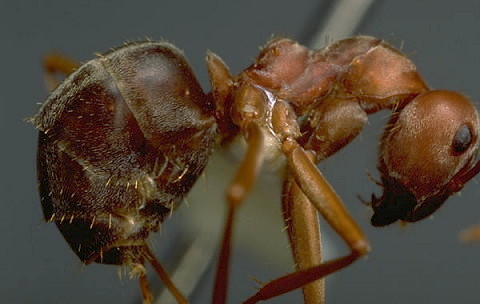 Internal
border of mandibles, apex of antenna, frontal carinae, apex of petiole
and gaster brown to near black. Whole of body, with the exception of
the mandible teeth, covered in decumbent pubescence, greyish yellow,
giving a remarkably silky appearance; this pubescence is strongest on
the gaster, least on the clypeus and genae; this partially hides the
true colour of the cuticle. On the dorsum of the gaster the pubescence
has a remarkable disposition, forming five evenly separated
longitudinal lines, running almost the entirety of the gaster, one
forming a median line; the pubescence changes direction in the
alternate lines as follows - the decumbent hairs on each side of the
median line are oblique from rear to front, then the second
longitudinal lines have the hairs oblique from front to back, the outer
lines have the hairs again oblique from rear to front, the overall
effect is of alternating black and grey lines. This is an optical
illusion as immersing the specimen in alcohol momentarily destroys the
reflections. Something of the same optical banding can be seen on the
pronotum when viewed from certain angles. There are strong sparse erect
hairs on all parts of the body, more abundant on the posterior of the
gaster, the anterior of the clypeus and the mandibles. Eyes without
hairs. The entire body is sculptured with fine rugosity, densely packed
giving a shagreened appearance. only the mandibles are strongly
longitudinally striate, the teeth being smooth. Internal
border of mandibles, apex of antenna, frontal carinae, apex of petiole
and gaster brown to near black. Whole of body, with the exception of
the mandible teeth, covered in decumbent pubescence, greyish yellow,
giving a remarkably silky appearance; this pubescence is strongest on
the gaster, least on the clypeus and genae; this partially hides the
true colour of the cuticle. On the dorsum of the gaster the pubescence
has a remarkable disposition, forming five evenly separated
longitudinal lines, running almost the entirety of the gaster, one
forming a median line; the pubescence changes direction in the
alternate lines as follows - the decumbent hairs on each side of the
median line are oblique from rear to front, then the second
longitudinal lines have the hairs oblique from front to back, the outer
lines have the hairs again oblique from rear to front, the overall
effect is of alternating black and grey lines. This is an optical
illusion as immersing the specimen in alcohol momentarily destroys the
reflections. Something of the same optical banding can be seen on the
pronotum when viewed from certain angles. There are strong sparse erect
hairs on all parts of the body, more abundant on the posterior of the
gaster, the anterior of the clypeus and the mandibles. Eyes without
hairs. The entire body is sculptured with fine rugosity, densely packed
giving a shagreened appearance. only the mandibles are strongly
longitudinally striate, the teeth being smooth.
Two specimens seen from Lesotho.
The colour image is from the AMNH collection at Antbase.org |
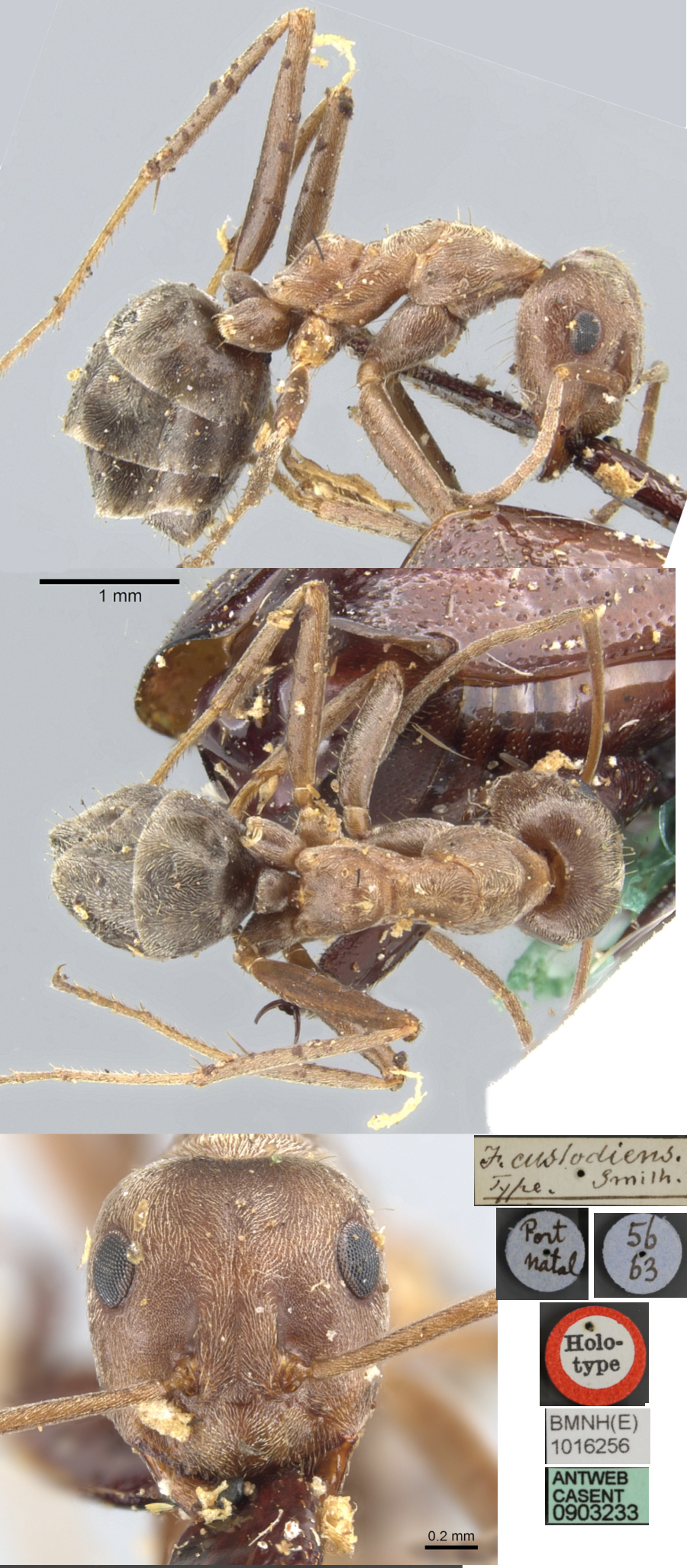 The
photomontage of the type worker is collated http://www.antweb.org/specimen.do?name=casent0903233. The
photomontage of the type worker is collated http://www.antweb.org/specimen.do?name=casent0903233.
|
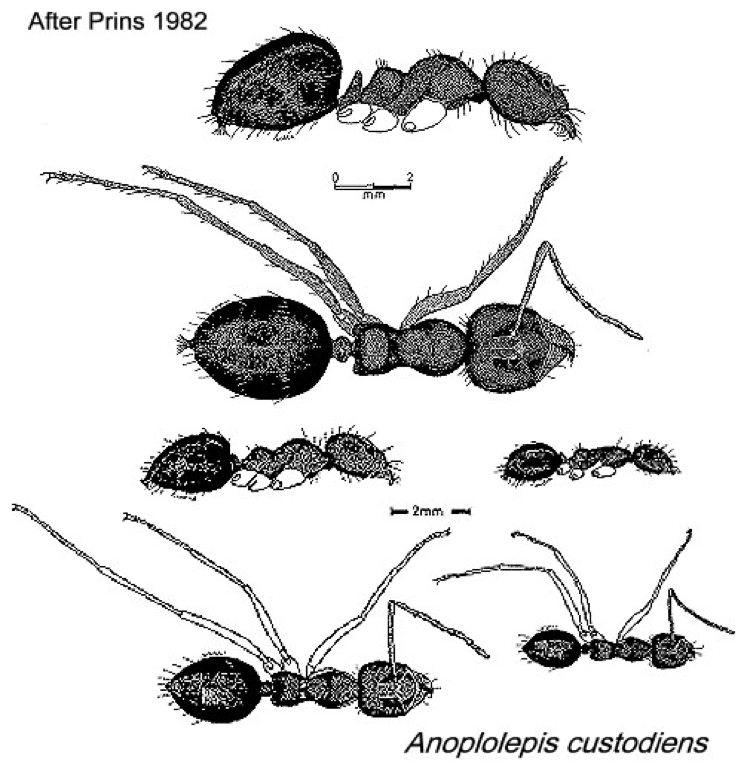 Prins
(1982) provided a comprehensive description of all forms, including
examples of worker polymorphism, with the TL ranging from 3-10 mm -
these are shown (right) in the much reduced compilation of his
excellent illustrations. Prins
(1982) provided a comprehensive description of all forms, including
examples of worker polymorphism, with the TL ranging from 3-10 mm -
these are shown (right) in the much reduced compilation of his
excellent illustrations.
|
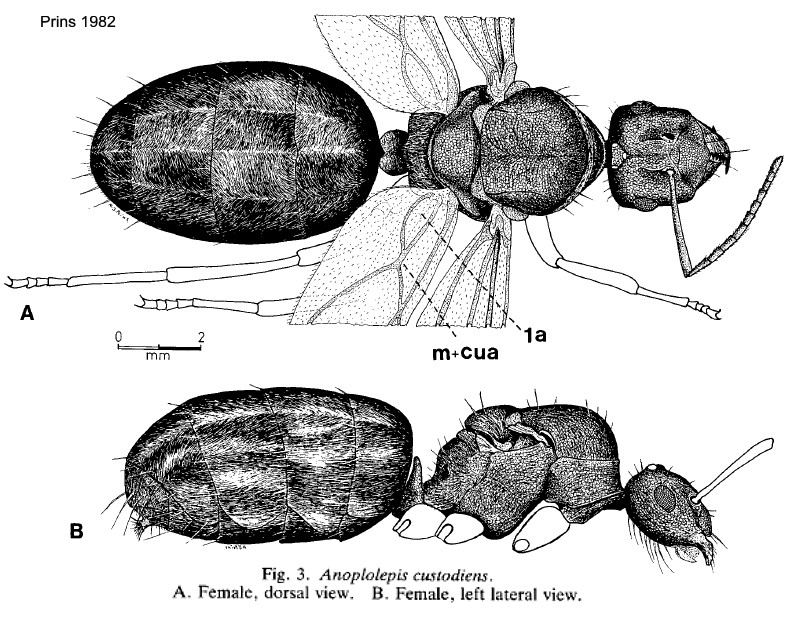 Queen
(Prins, 1982). See also the fresh queen (bottom). Queen
(Prins, 1982). See also the fresh queen (bottom).
|
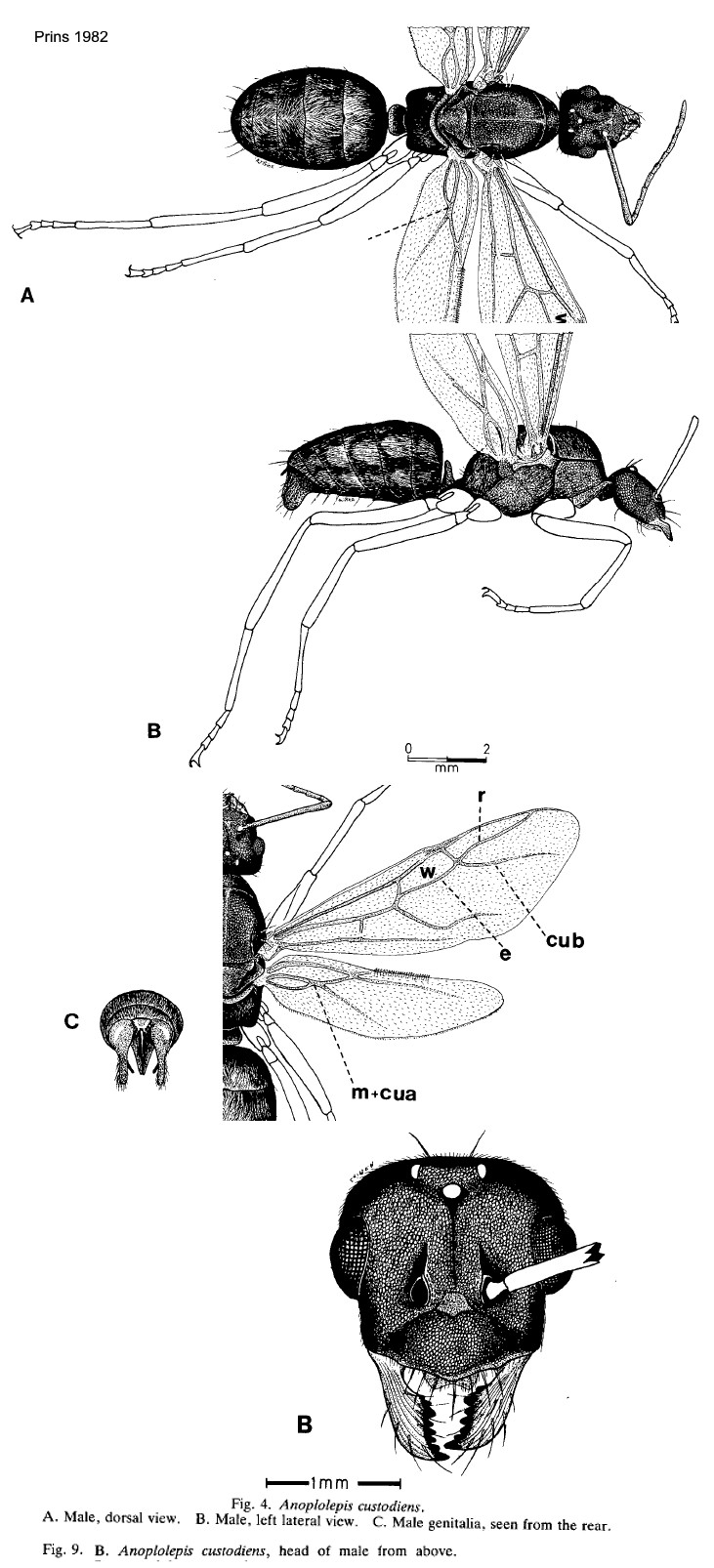 Male (Prins, 1982). Male (Prins, 1982).
|
Recorded by Forel (1909b), as Plagiolepis custodiens,
from Zaļre, at Banana by Busschodts.
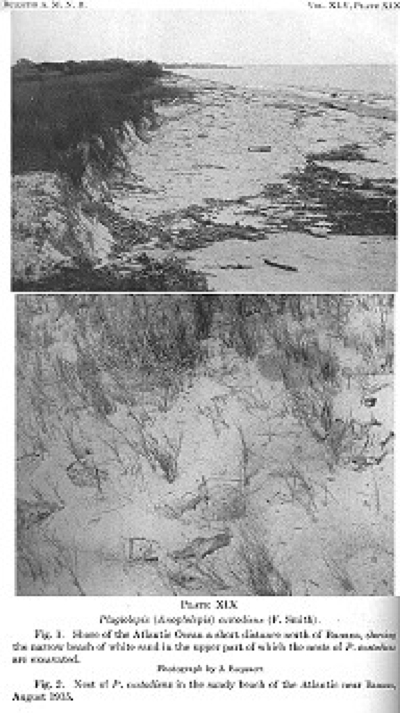 Wheeler (1922) wrote of Zaļre findings at
Banana, San Antonio (Lang and Chapin). At Banana this species was found
nesting in flat craters in the pure sand of the sea-beach (PL. XIX,
figs. 1 and 2; see left and "click"). According to a note by Mr. Lang,
"the ants were found very near the water, where the sand was moved by
the wind or even inundated by the breakers. Only a slight excavation,
marking the entrance of the nest, was visible, and it was difficult to
trace out the galleries. These ants carry particles of sand
considerable distances, sometimes two or three feet from the nest
entrances. They work during the day-time and retreat into their nests
when disturbed." Wheeler (1922) wrote of Zaļre findings at
Banana, San Antonio (Lang and Chapin). At Banana this species was found
nesting in flat craters in the pure sand of the sea-beach (PL. XIX,
figs. 1 and 2; see left and "click"). According to a note by Mr. Lang,
"the ants were found very near the water, where the sand was moved by
the wind or even inundated by the breakers. Only a slight excavation,
marking the entrance of the nest, was visible, and it was difficult to
trace out the galleries. These ants carry particles of sand
considerable distances, sometimes two or three feet from the nest
entrances. They work during the day-time and retreat into their nests
when disturbed."
A. custodiens has been previously taken in Banana by
Busschodts and in Angola by Silvestri, and is well known from other
parts of the Ethiopian Region as far north as Abyssinia and as far
south as the Cape. It is the host of (the parasitic species) A.
nuptialis Santschi, which was discovered by Dr. Brauns at
Willowmore, Cape Province.
|
Oxford University Museum
specimens
Anoplolepis (Zealleyella) custodiens
B Taylor det.
|
South Africa
S Danflous
|
6.xii.2007
Sudwala Caves
25°22'09" S
30°41'58" E
|
Gaufeng Province;
166 m
|
4
|
 |
Anoplolepis (Zealleyella) custodiens
B Taylor det. |
Tanzania
G C McGavin
OUMNH-2005-007
|
25.xii.2004
Kigamboni Dist
07°03.17' S
39°32.68'E
|
'Cheng Chem Camp'
on cashew tree
major & media workers |
5
|
 |
|
South African specimens
 The photomontage is
of a major worker collected from
South Africa, Sudwala Caves, Gaufeng Province; collector Sam Danflous,
6.xii.2007. The photomontage is
of a major worker collected from
South Africa, Sudwala Caves, Gaufeng Province; collector Sam Danflous,
6.xii.2007.
|
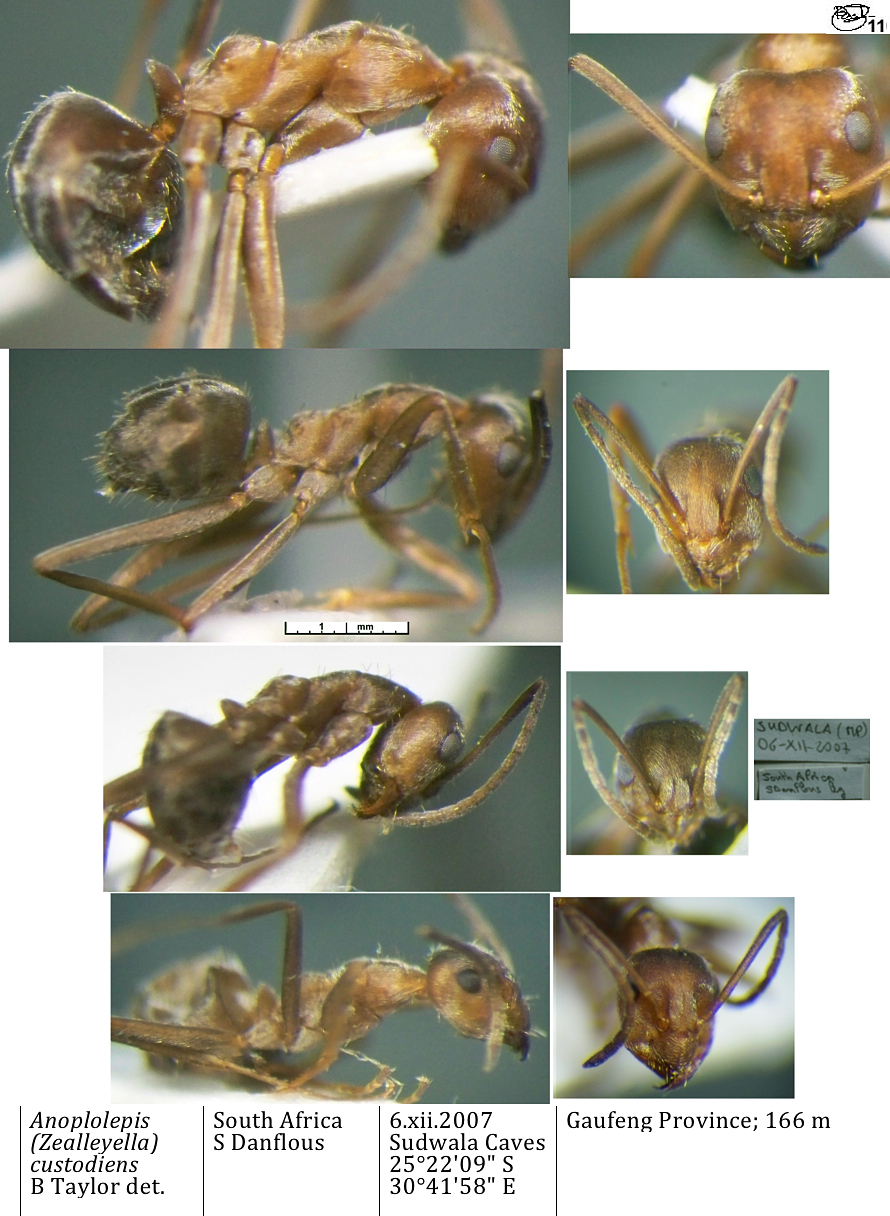 The
photomontage is showing polymorphism of workers is compiled from
specimens collected as above at Sudwala, South Africa. The
photomontage is showing polymorphism of workers is compiled from
specimens collected as above at Sudwala, South Africa.
|
 The photograph right is of a specimen from Addo
Elephant Park, South Africa, and is reduced from the superb
Myrmecos.net original taken by Alex Wild (click to see original). The photograph right is of a specimen from Addo
Elephant Park, South Africa, and is reduced from the superb
Myrmecos.net original taken by Alex Wild (click to see original).
|
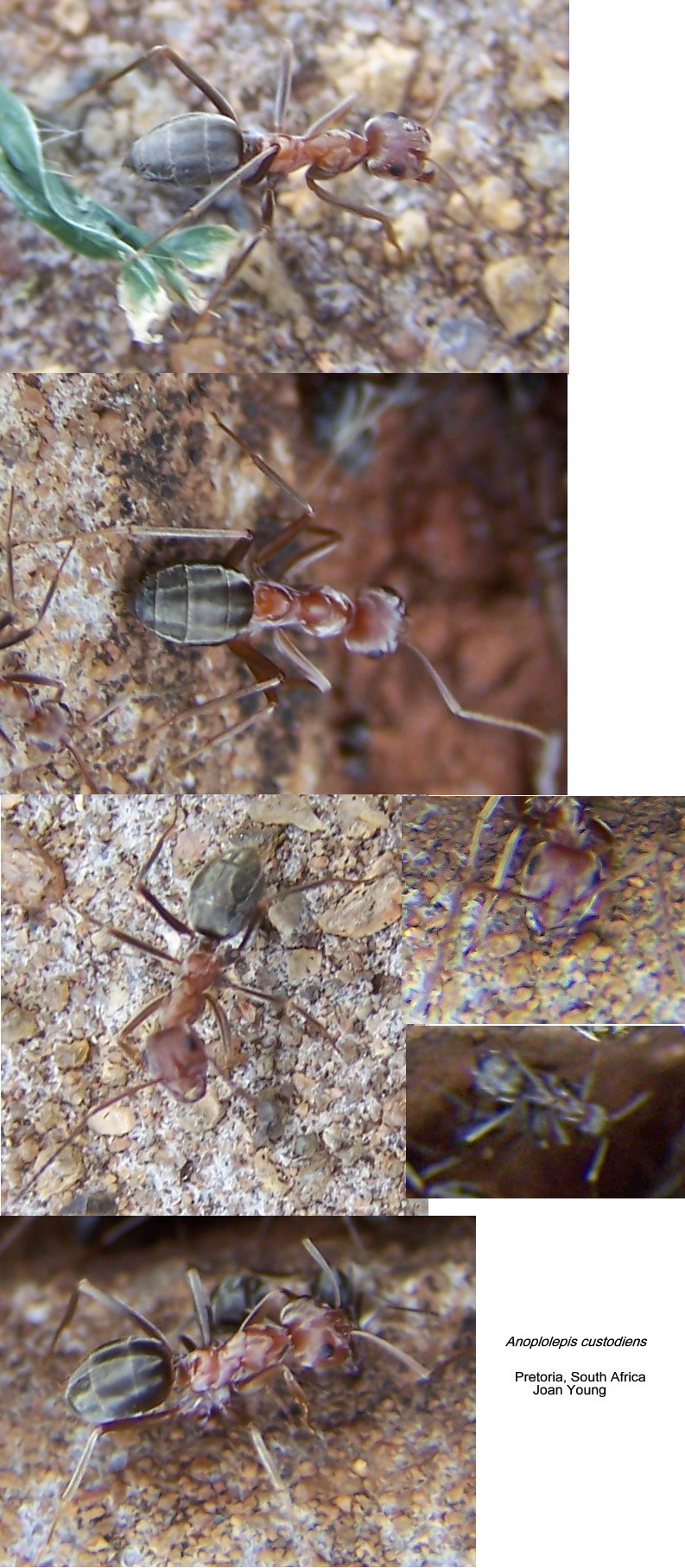 The
specimens in these field photographs were taken in Pretoria, South
Africa, by Joan Young; nos 101-6402, 101-6405, 101-6406 & 101-6408 The
specimens in these field photographs were taken in Pretoria, South
Africa, by Joan Young; nos 101-6402, 101-6405, 101-6406 & 101-6408
|
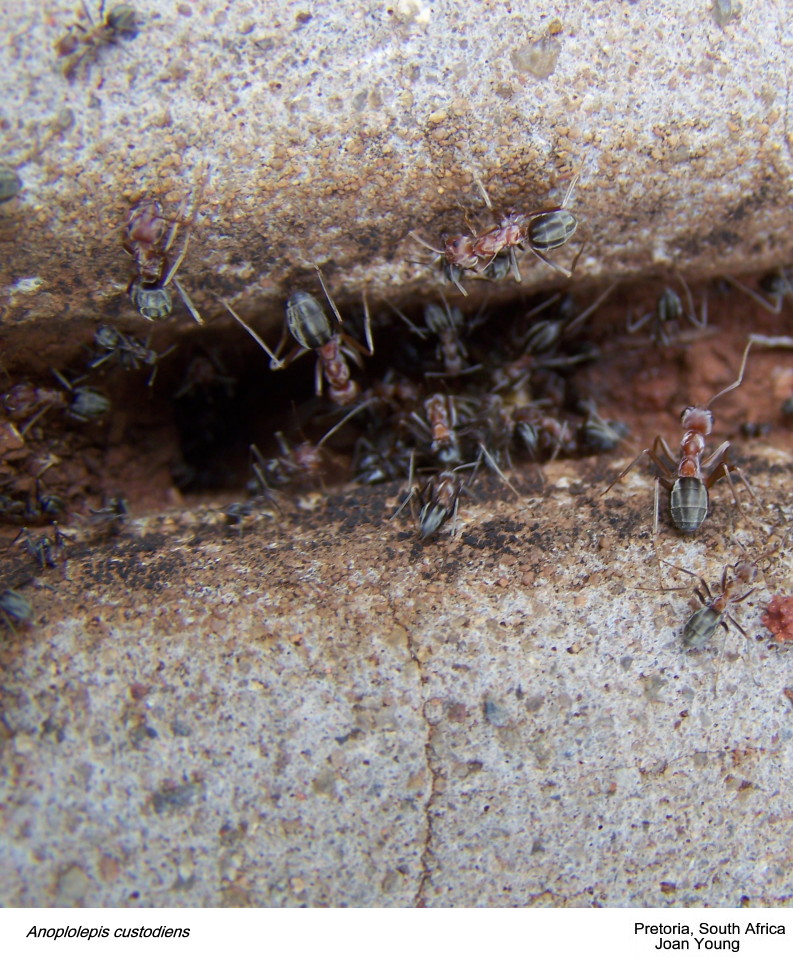 J Young J Young
|
 A second nest entrance, by J Young; nos IMG 7779 t0 77786 A second nest entrance, by J Young; nos IMG 7779 t0 77786
|
Tanzania specimens
 The photomontage is
of a major worker collected from Tanzania, Kigamboni; collector G C
McGavin. The photomontage is
of a major worker collected from Tanzania, Kigamboni; collector G C
McGavin.
|
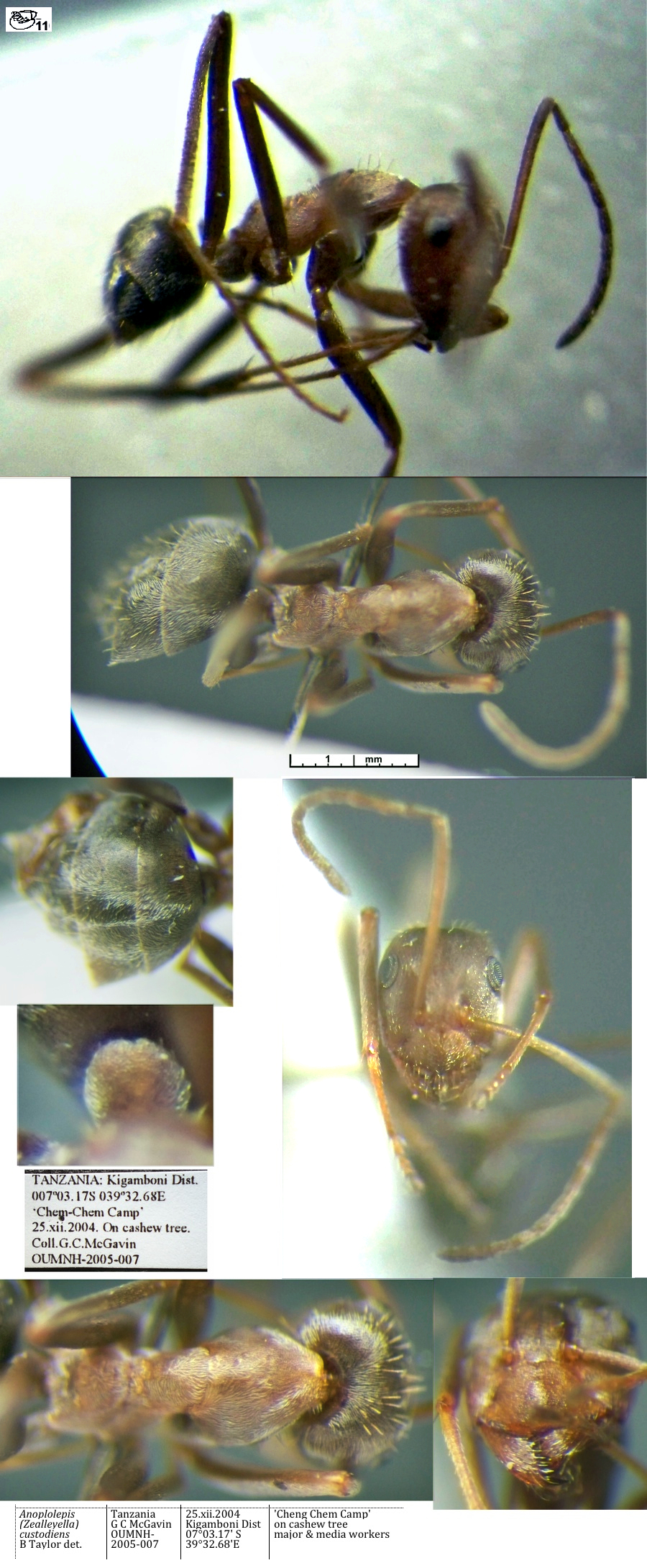 The
photomontage is
of a media worker collected from Tanzania, Kigamboni; collector G C
McGavin. The
photomontage is
of a media worker collected from Tanzania, Kigamboni; collector G C
McGavin.
|
 The
photomontage of a fresh queen is collated http://www.antweb.org/specimen.do?name=casent0903233. The
photomontage of a fresh queen is collated http://www.antweb.org/specimen.do?name=casent0903233.
|
|